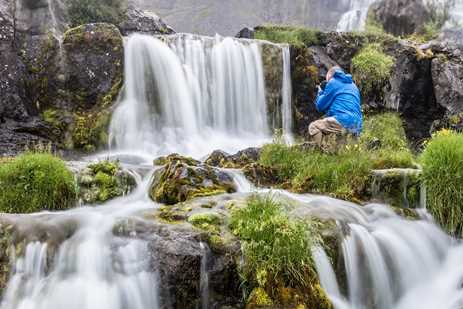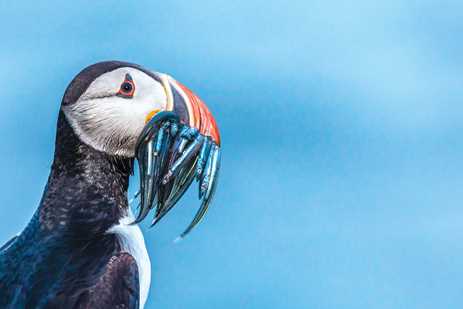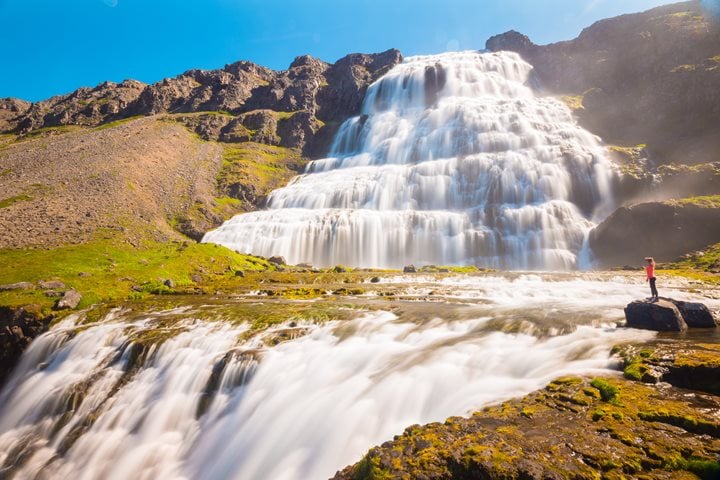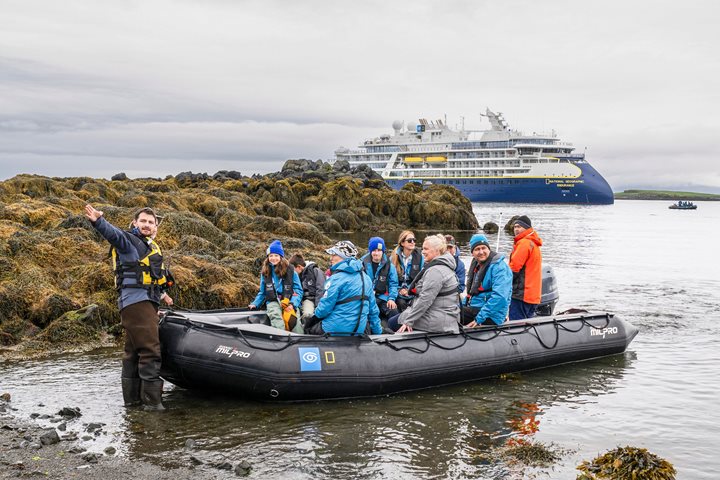Iceland is defined by its dramatic landscape created by centuries of geological upheaval. It can be hard to put this wild and otherworldly place into words which means you’ll definitely want to capture it on camera. Naturalist and certified photo instructor Andrew Peacock feels very lucky to have made several circumnavigations of Iceland with National Geographic-Lindblad Expeditions. “I love that there is so much subject diversity. The incredible vistas, abundant wildlife and fascinating Icelandic culture provide so many opportunities to create interesting photos.” Below, he shares some of his top tips (along with his stunning photos) for shooting in the land of fire and ice. Get Inspired By Photos, Videos, Webinars, Stories, And Exclusive Offers. Sign Up
Embrace the Weather
The weather here is just as changeable and dramatic as the landscape and a photographer seeking blue skies or pastel sunset hues may well be disappointed. My tip is to embrace those inevitable cloudy grey days and seek to tell a story of what it might feel like to experience these conditions.
This photo was taken exploring the island of Vigur in the remote Westfjords. The imposing silhouette of Mt. Hestur (Mt. Horse) along with those low-hanging clouds creates a somber moody scene. To add an additional storytelling element, I waited for the moment when a bird (possibly a fulmar) crossed the frame. It creates a reminder that wind and storms are a signature feature of the environment for the significant birdlife that can be found in the area.
Don't Underestimate Your Smartphone
It’s easy to get caught up in the idea that taking a great photo requires professional level camera gear. In fact, this old adage rings more true to me: "the best camera is the one you happen to have with you at the moment inspiration strikes."
Just about everyone has a smartphone these days. They take great pictures, are easy to carry, and are instantly accessible for photography with a quick thumb swipe. So, don’t forget your phone when it comes to telling your story of exploring Iceland.
This is one of my favorite photos taken on my iPhone during one of our land-based excursions. It captures a tender moment between a young guest and a beautiful horse. This breed is uniquely Icelandic and holds a special place in the culture of this volcanic land.
Work Your Subject
Diamond Beach is a strip of black sand near Jökulsárlón glacier lagoon where numerous small icebergs get washed up on shore, making it a fantastic spot for photographers. It pays to take some time walking up and down the beach here to find a piece of ice that really piques your interest.
Once you do, “work the subject”: photograph the ice from all angles, vary the shutter speed, change the lens focal length—shoot wide and shoot tight. Be creative and don’t just settle for one or two photos and think you’ve nailed it because you almost certainly won’t have!
Ice is a wonderful subject for creative photography especially when it’s glowing blue against a dark backdrop. For this photo, I wore rubber boots so I could get in close to the ice and I used a tripod and neutral density filter to allow for a very slow shutter speed to blur the water surging on the shore. Just one of many ways of “working this subject.”
Be Patient & Be Present
A visit to the tiny island of Grimsey which straddles the Arctic Circle is a highlight of Iceland voyages with National Geographic-Lindblad Expeditions. This is a wonderful place to photograph the Atlantic puffins that come and go from their clifftop nesting sites.
These birds fly fast and grabbing a sharp close-up photo of them in flight is a challenge for even the very best wildlife photographer. Instead, aim for an easier but no less evocative photo by finding a spot on the cliff top and taking a seat for a while. Not too close to the edge of course and just close enough to the birds so you can frame them for a portrait with a medium or long telephoto lens.
The key is to be patient and watch for an interesting moment like this when a puffin briefly looked in my direction. I also encourage you to put down the camera for long periods so you can actively watch these fascinating birds, learn about their behavior and not be solely focused on "getting a shot!"
Look for Color
Heimaey Island, the largest of the Westman Islands and the only inhabited one, is a favorite destination of mine in Iceland. The Eldfell volcano erupted there in 1973 forcing the evacuation of the residents and bringing the island to worldwide attention. A lot of landscapes in Iceland are muted earth tones but on this trail that explores the area where the lava once flowed, you have an opportunity to capture some bright color.
The plants in my photo, the blue Nootka lupine, are native to North America but are a familiar sight in Iceland having spread wildly after they were introduced in the late 1970s to halt soil erosion. When featured in the foreground, as in this composition looking out over town, the plants certainly provide some nice, saturated color to help make the photo “pop.” The red rooftops add an another interesting hit of color.
Bring a Tripod for Waterfalls
Another excellent highlight on the itinerary, Dynjandi is a majestic, multi-tiered waterfall in the Westfjords. I love photographing there because the light is always changing—sometimes its foggy, other times the sun is out but it’s always dramatic and spectacular.
For locations like this, bring a tripod so you can use a slow shutter speed (one second for this photo) which will give the thundering waterfall an ethereal silky appearance. Holding a DSLR camera in your hand for one second will just blur everything which is not what you're going for. If you’re using a smartphone, there are many small stands you can buy so you can achieve the same look, especially if you use the ‘Live’ function offered on iPhones.
Experimenting with different length shutter speeds will produce different degrees of blurring of the water. In this instance, I wanted to add perspective to give the viewer a sense of the grandeur of this landscape. I asked a naturalist to stop and hold still for a few seconds at that exact spot in my frame where I knew she would stand out against the white water.








